PONTIAC FIERO 1988 Service Repair Manual
Manufacturer: PONTIAC, Model Year: 1988, Model line: FIERO, Model: PONTIAC FIERO 1988Pages: 1825, PDF Size: 99.44 MB
Page 881 of 1825
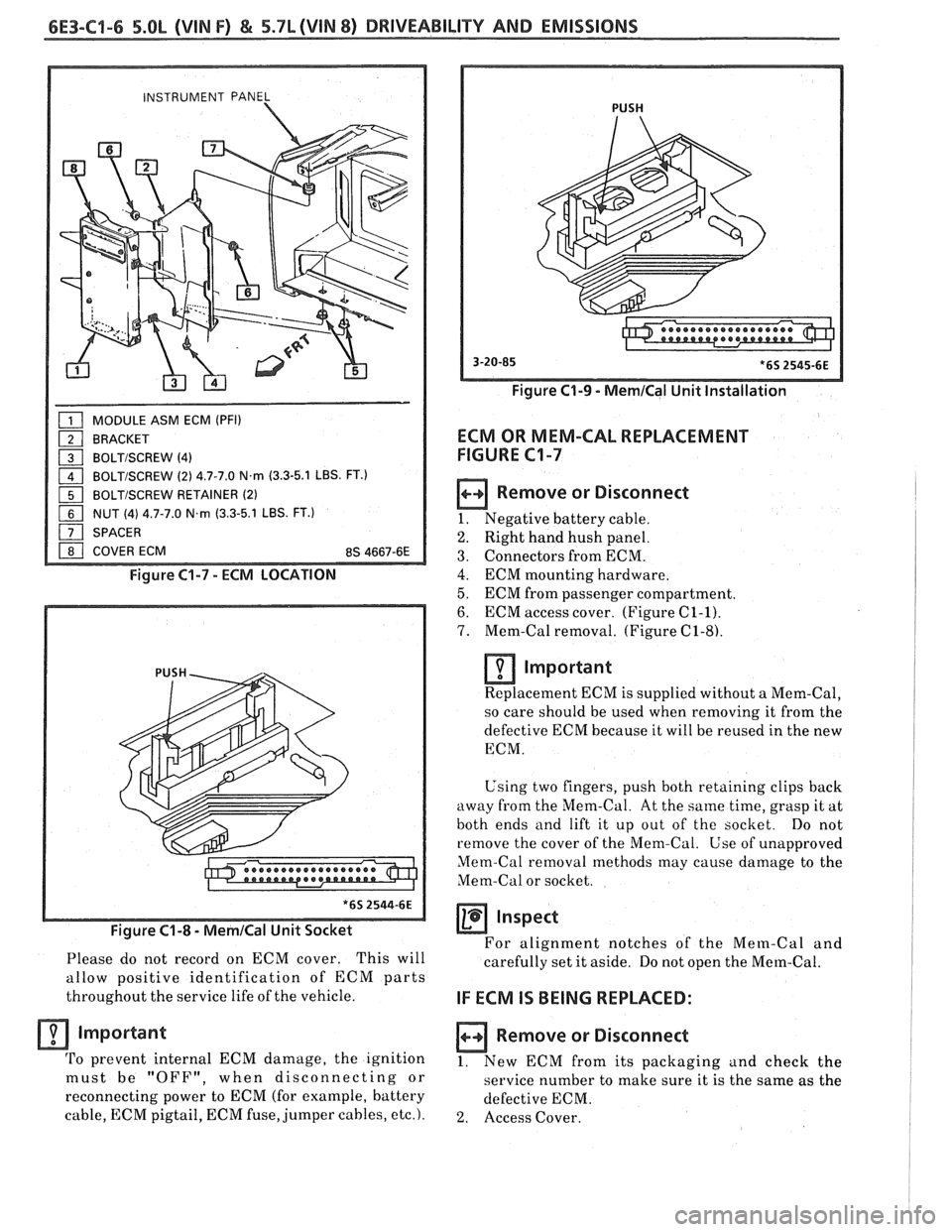
6E3-C9-6 5.OL (VIN F) & 5.7L (VIN 8) DRIVEABILIW AND EMISSIONS
INSTRUMENT PANEL 1
MODULE ASM ECM (PFI)
BRACKET
a BOLTISCREW (4)
1 BOLTISCREW (2) 4.7-7.0 N.m (3.3-5.1 LBS. FT.)
1 BOLTISCREW RETAINER (2)
NUT (4) 4.7-7.0 N.m (3.3-5.1 LBS. FT.)
SPACER
I 1 COVER ECM 8s 4667-6E 1
Figure C1-7 - ECM LOCATION
Figure
C1-8 - MemICal Unit Socket
Please do not record on ECM cover. This will
allow positive identification of ECM parts
throughout the service life of the vehicle.
Important
'I'o prevent internal ECM damage, the ignition
must be "OFF", when
disconnecting or
reconnecting power to ECM (for example, battery
cable, ECM pigtail, ECM fuse, jumper cables,
etc.).
PUSH
Figure C1-9 - MernICal Unit Installation
ECM OR MEM-CAL REPLACEMENT
FIGURE
C1-7
Remove or Disconnect
1. Negative battery cable.
2. Right hand hush panel.
3. Connectors from ECM.
4. ECM mounting hardware.
5. ECM from passenger compartment.
6. ECM access cover. (Figure C1-1).
7. Mem-Cal removal. (Figure C1-8).
lmportant
Replacement ECM is supplied without a Mem-Cal,
so care should be used when removing it from the
defective ECM because it will be reused
in the new
ECM.
Using two fingers, push both retaining clips back
away from the Mem-Cal. At the
same time, grasp it at
both ends and lift it up out of the socket. Do not
remove the cover of the Mem-Cal.
Use of unapproved
Mem-Cal removal methods may cause damage to the
Mem-Cal or socket.
Inspect
For alignment notches of the Mem-Cal and
carefully set it aside. Do not open the
Mern-Cal.
IF ECM IS BEING REPLACED:
Remove or Disconnect
1. New ECM from its packaging and check the - -
service number to make sure it is the same as the
defective ECM.
2. Access Cover.
Page 882 of 1825
![PONTIAC FIERO 1988 Service Repair Manual
DRIVEABILITY AND EMISSIONS 5.OL (VIN F) & 5.7L (VIN 8) 6E3-C1-7
UPPER RADIATOR
/ MAF SENSOR ASM
1 CLAMP ASM 1.4-2.0 N-rn (1-1.4 LBS. FT.) 1 BOLTISCREW (2)
1 BRACI<ET MAF SENSOR I5] BOLTISCREW (2 PONTIAC FIERO 1988 Service Repair Manual
DRIVEABILITY AND EMISSIONS 5.OL (VIN F) & 5.7L (VIN 8) 6E3-C1-7
UPPER RADIATOR
/ MAF SENSOR ASM
1 CLAMP ASM 1.4-2.0 N-rn (1-1.4 LBS. FT.) 1 BOLTISCREW (2)
1 BRACI<ET MAF SENSOR I5] BOLTISCREW (2](/img/50/57415/w960_57415-881.png)
DRIVEABILITY AND EMISSIONS 5.OL (VIN F) & 5.7L (VIN 8) 6E3-C1-7
UPPER RADIATOR
/ MAF SENSOR ASM
1 CLAMP ASM 1.4-2.0 N-rn (1-1.4 LBS. FT.) 1 BOLTISCREW (2)
1 BRACI
Install or Connect (Figure C1-9)
1. Mem-Cal in Mem-Cal socket.
Important
Press only on the ends of the Mem-Cal.
Small notches in the Mem-Cal must be aligned
with the small notches in the Mem-Cal socket.
Press on the ends of the Mem-Cal until the
retaining clips snap into the ends of the Mem-Cal.
Do not press on the middle of the Mem-Cal, only
on the ends.
2. Access cover on ECM.
3. ECM in passenger compartment.
4. Connectors to ECM.
5. Right hand hush panel.
6. Negative battery cable.
Functional Check
1. Turn ignition "ON".
2. Enter diagnostics.
A. Allow Code
12 to flash four times to verify no
other codes are present.
This indicates the Mem-Cal is installed
properly and the ECM is functioning.
B. If trouble Code 51 occurs, or if the "Service
Engine Soon" light is "ON" constantly with no
codes, the Mem-Cal is not fully seated or is
defective.
@ If not fully seated, press firmly on the ends
of the Mem-Cal.
If it is necessary to remove the Mem-Cal,
follow the previous removal instructions.
COOLANT SENSOR
NOTICE:
Care must be taken when handling
coolant sensor. Damage to coolant sensor
will affect proper operation of the fuel
injection system.
Remove or Disconnect
1. Negative battery cable.
2. Air inlet duct.
3. Electrical connector.
4. Carefully back out coolant sensor.
Install or Connect
1. Sensor in engine.
2. Electrical connector.
3. Air inlet tube.
4. Negative battery cable.
ENGINE HARNESS ASM
Figure Cl-1 l Relays
Page 883 of 1825
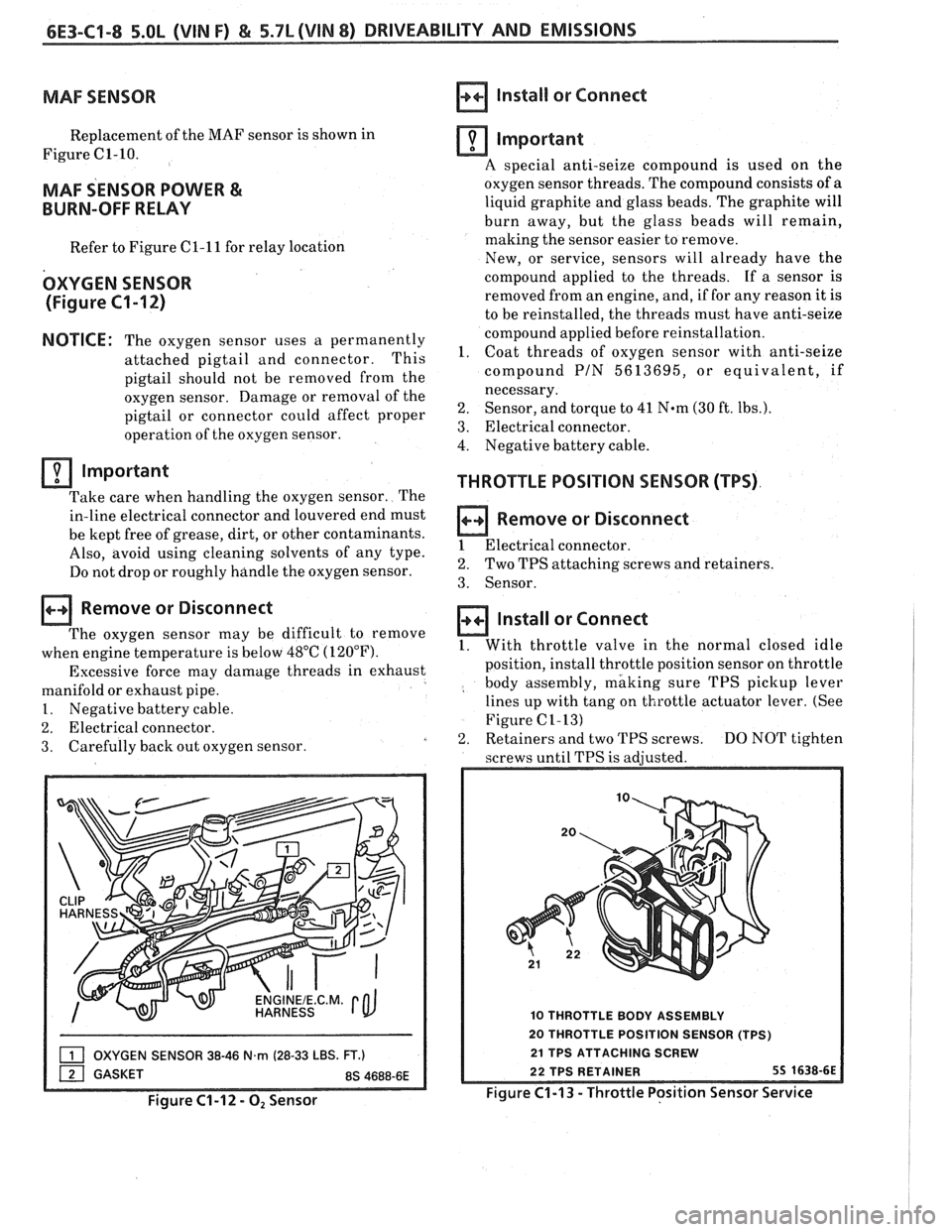
6E3-C1-8 5.OL (VIN F) & 5.7L (VIN 8) DRIVEABILITY AND EMISSIONS
MAF SENSOR Install or Connect
Replacement of the MAF sensor is shown in
Figure C1-10.
MAF SENSOR POWER &
BURN-OFF RELAY
Refer to Figure C1-11 for relay location
OXYGEN SENSOR
(Figure
C1-12)
NOTICE: The oxygen sensor uses a permanently
attached pigtail and connector. This
pigtail should not be removed
from the
oxygen sensor. Damage or removal of the
pigtail or connector could affect proper
operation of the oxygen sensor.
Important
Take care when handling the oxygen sensor. The
in-line electrical connector and louvered end must
be kept free of grease, dirt, or other contaminants.
Also, avoid using cleaning solvents of any type.
Do not drop or roughly handle the oxygen sensor.
Remove or Disconnect
The oxygen sensor may be difficult to remove
when engine temperature is below 48°C (120°F).
Excessive force may damage threads in exhaust
manifold or exhaust pipe.
1. Negative battery cable.
2. Electrical connector.
3. Carefully
back out oxygen sensor.
OXYGEN SENSOR 38-46 N.rn (28-33 LBS. FT.)
Figure C1-12 - 0, Sensor
Important
A special anti-seize compound is used on the
oxygen sensor threads. The compound consists of
a
liquid graphite and glass beads. The graphite will
burn away, but the glass beads will remain,
making the sensor easier to remove.
New, or service, sensors will already have the
compound applied to the threads. If a sensor is
removed from an engine, and, if for any reason it is
to be reinstalled, the threads must have anti-seize
compound applied before reinstallation.
1. Coat threads of oxygen sensor with anti-seize
compound
PIN 5613695, or equivalent, if
necessary.
2. Sensor, and torque to 41 N*m (30 ft. lbs.).
3. Electrical connector.
4. Negative battery cable.
THROTTLE POSITION SENSOR (TPS)
Remove or Disconnect
1 Electrical connector.
2. Two TPS attaching screws and retainers.
3. Sensor.
Install or Connect
1. With throttle valve in the normal closed idle
position, install throttle position sensor on throttle
body assembly, making sure TPS
picltup lever
lines up with tang on throttle actuator lever. (See
Figure
C1-13)
2. Retainers and two TPS screws. DO NOT tighten
screws until TPS is adjusted.
10 THROTTLE BODY ASSEMBLY
20 THROTTLE POSITION SENSOR (TPS)
21 TPS ATTACHING SCREW
Figure
C1-13 - Throttle Position Sensor Service
Page 884 of 1825
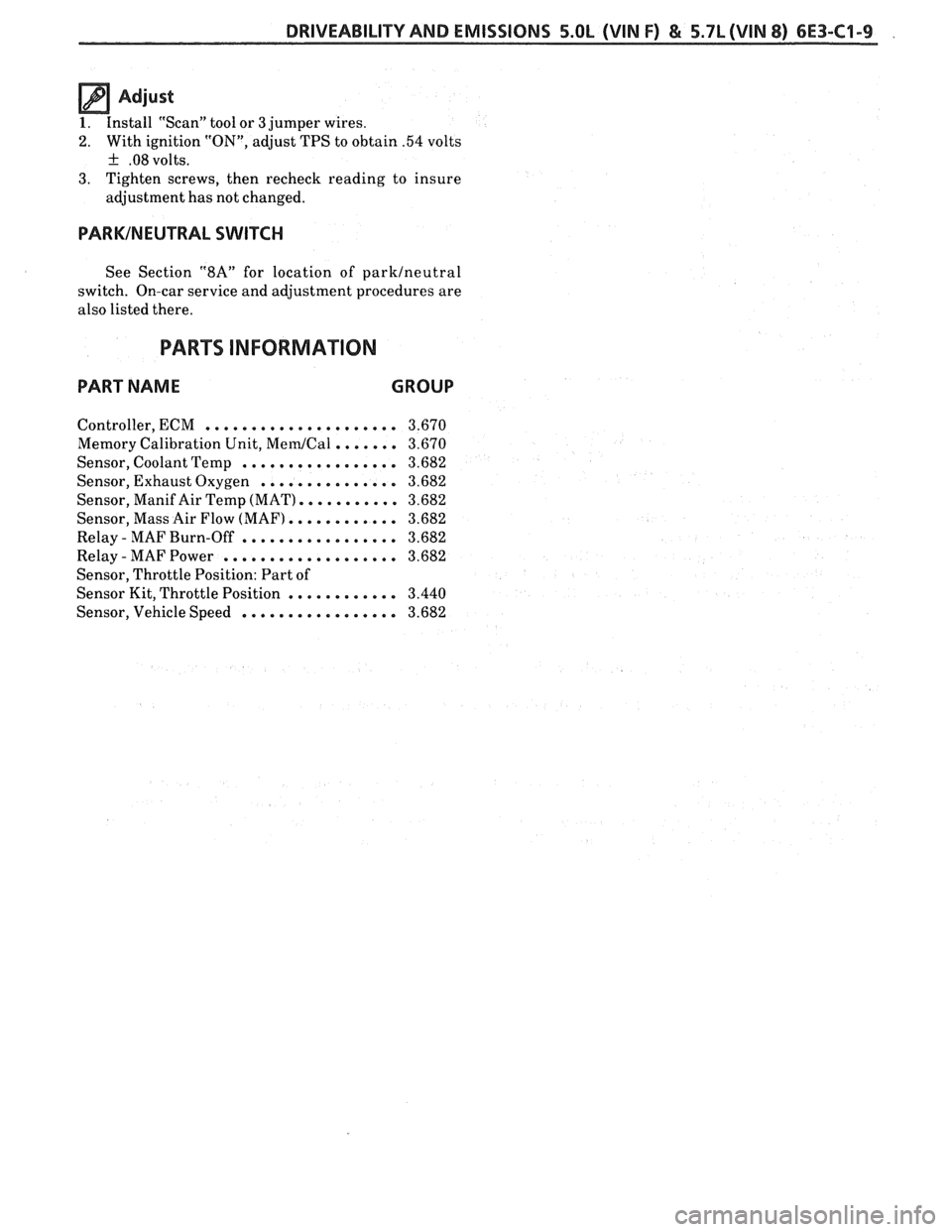
DRIVEABILITY AND EMISSIONS 5.OL (VIN F) & 5.7L (WIN 8) 6E3-C1-9
Adjust
1. Install "Scan" tool or 3 jumper wires.
2. With ignition "ON", adjust TPS to obtain .54 volts
+ .08 volts.
3. Tighten screws, then recheck reading to insure
adjustment has not changed.
PARKINEUTRAL SWITCH
See Section "8A" for location of parklneutral
switch. On-car service and adjustment procedures are
also listed there.
PARTS INFORMATION
PART NAME CROUP
Controller, ECM ..................... 3.670
Memory Calibration Unit, MemICal ....... 3.670
Sensor, Coolant Temp ................. 3.682
Sensor, Exhaust Oxygen ............... 3.682
Sensor, Manif Air Temp (MAT). .......... 3.682
Sensor, Mass Air Flow (MAF) ............ 3.682
Relay - MAF Burn-Off ................. 3.682
Relay - MAF Power ................... 3.682
Sensor, Throttle Position: Part of
Sensor Kit, Throttle Position
............ 3.440
Sensor, Vehicle Speed ................. 3.682
Page 885 of 1825
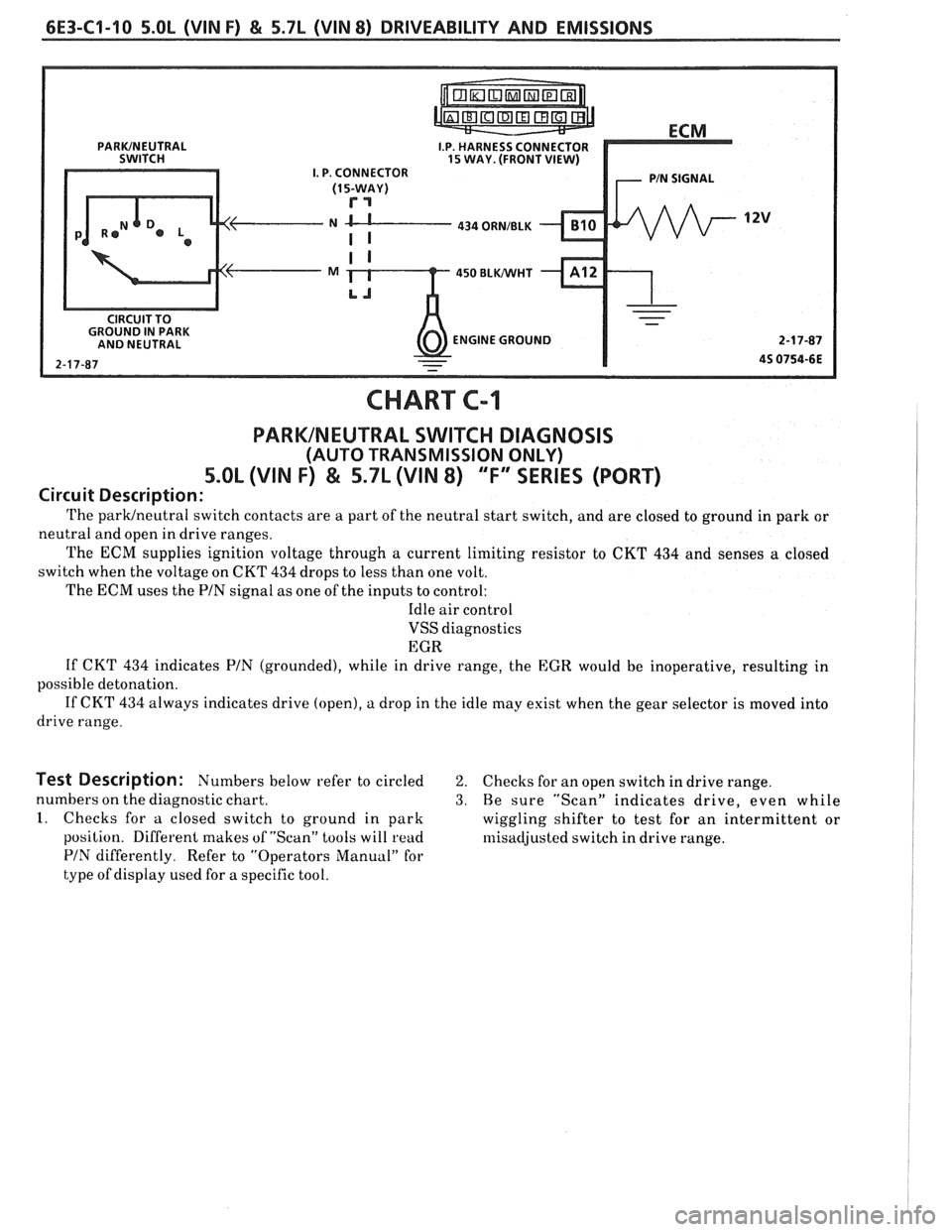
6E3-C1-10 5.OL (VIN F) & 5.7L (VIN 8) DRIVEABILITY AND EMISSIONS
I.P. HARNESS CONNECTOR 15 WAY. (FRONT VIEW) I. P. CONNECTOR
N CL---- 434 ORNIBLK
450 BLWHT
ENGINE GROUND
CHART C-1
PARKINEUTRAL SWITCH DIAGNOSIS
(AUTO TRANSMISSION ONLY)
5.OL (VIN F) & 5.7L (VIN 8) "F" SERIES (PORT)
Circuit Description:
The parwneutral switch contacts are a part of the neutral start switch, and are closed to ground in park or
neutral and open in drive ranges.
The
ECM supplies ignition voltage through a current limiting resistor to CKT 434 and senses a closed
switch when the voltage on CKT
434 drops to less than one volt.
The ECM uses the PIN signal as one of the inputs to control:
Idle air control
VSS diagnostics
EGR
If CKT
434 indicates PIN (grounded), while in drive range, the EGR would be inoperative, resulting in
possible detonation.
If CKT 434 always indicates drive (open), a drop in the idle may exist when the gear selector is moved into
drive range.
Test Description: Numbers below refer to circled 2. Checks for an open switch in drive range.
numbers on the diagnostic chart.
3. Be sure "Scan" indicates drive, even while
1. Checks for a closed switch to ground in park
wiggling shifter to test for an intermittent or
position. Different makes of "Scan" tools will
read rllisadjusted switch in drive range.
PIN differently. Refer to "Operators Manual" for
type of display used for a specific tool.
Page 886 of 1825
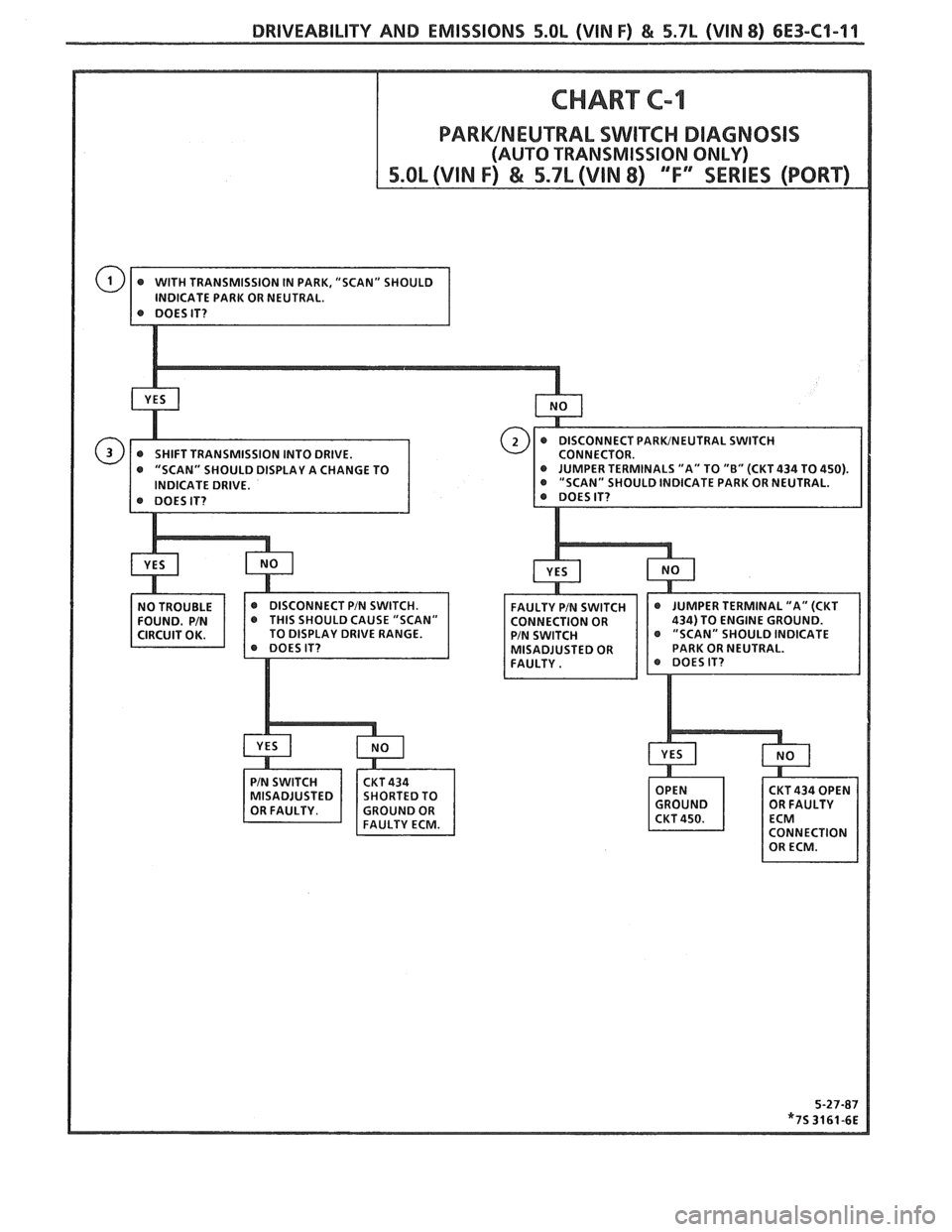
DRIVEABILITY AND EMISSIONS 5.OL (VIN F) & 5.7L (VIN 8) 6E3-C1-11
INALS "A" TO "B" (CKT 434 TO 450). LD INDICATE PARK OR NEUTRAL.
Page 887 of 1825
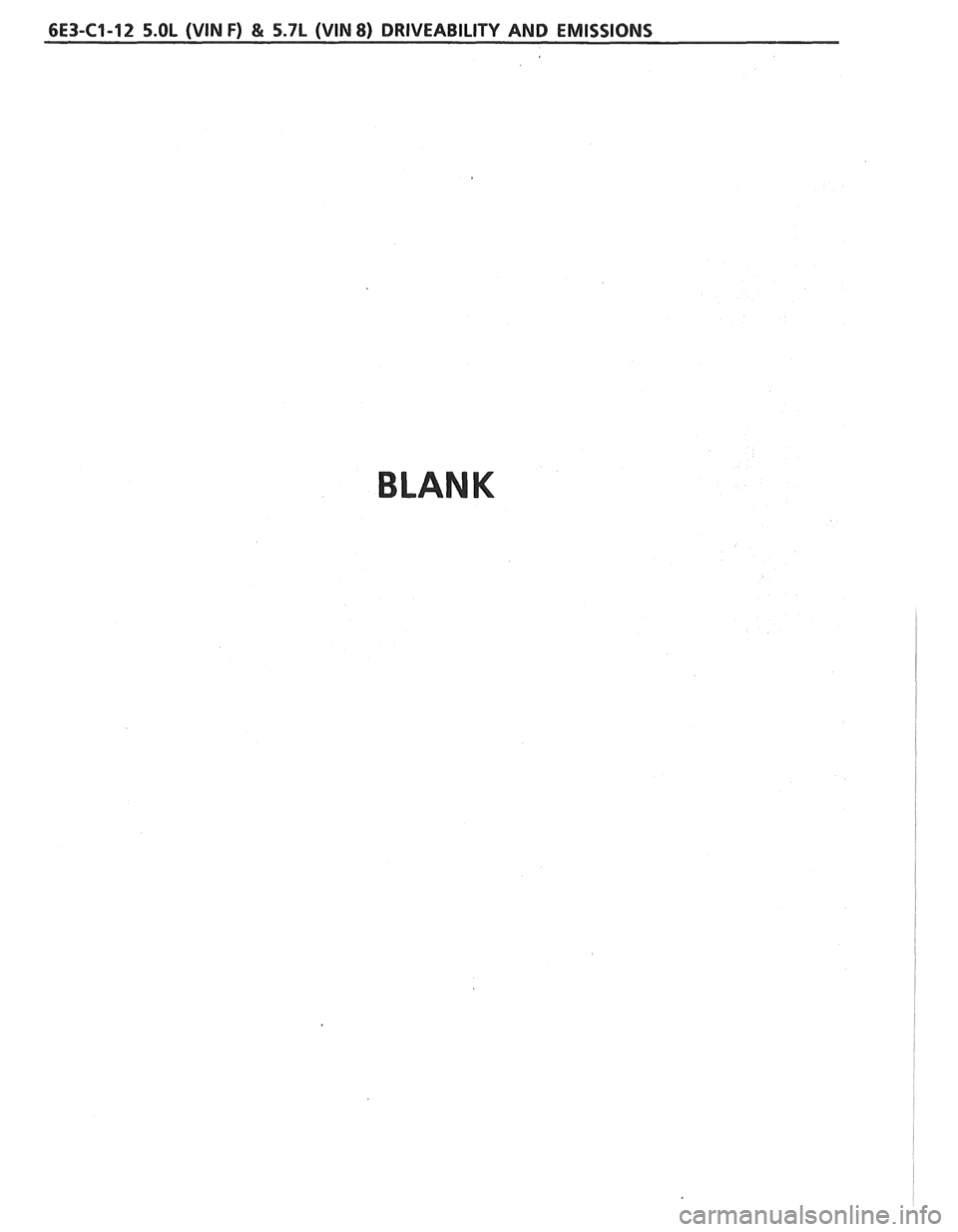
6E3-C1-12 5.OL (VIN F) & 5.7L (WIN 8) DRIVEABILITY AND EMISSIONS
BLANK
Page 888 of 1825
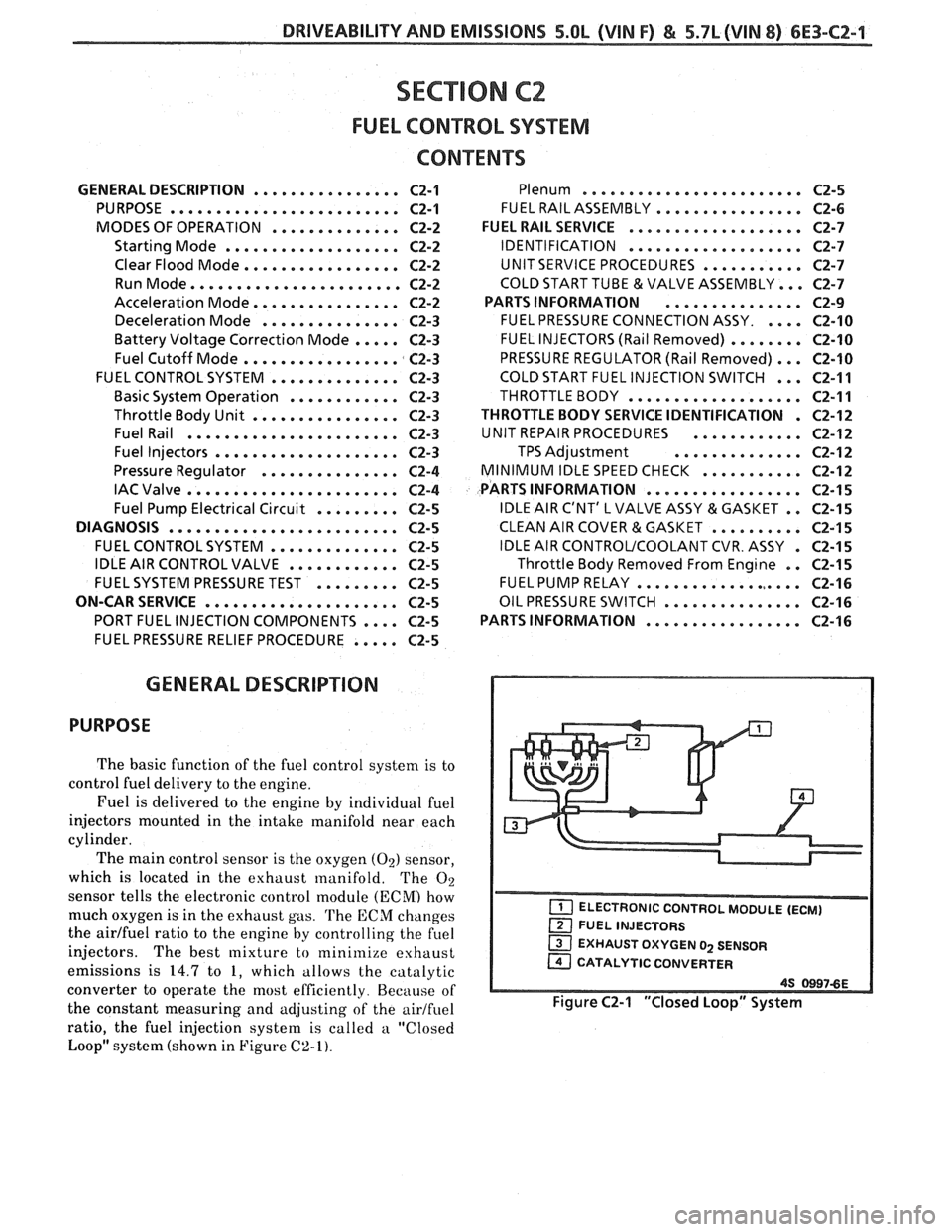
DRIVEABILITY AND EMISSIONS 5.OL (VIN F) & 5.7L (VIN 8) 6E3-C2-1
SECTION C2
FUEL CONTROL SYSEENI
CONTENTS
GENERAL DESCRIPTION . . . . . . . . . . . . . . . . C2-1
PURPOSE ........................ C2-1
MODES OF OPERATION . . . . . . . . . . . . . . C2-2
Starting Mode . . . . . . . . . . . . . . . . . . . C2-2
Clear Flood Mode.. . . . . . . . . . . . . . . . C2-2
Run Mode.. . . . . . . . . . . . . . . . . . . . . . C2-2
Acceleration Mode.. . . . . . . . . . . . . . . C2-2
Deceleration Mode . . . . . . . . . . . . . . . C2-3
Battery Voltage Correction Mode . . . . . C2-3
Fuel Cutoff Mode . , . . . . . . . . . . . . . . . C2-3
FUEL CONTROL SYSTEM . . . . . . . . . . . . . . C2-3
Basic System Operation . . . . . . . . . . . . C2-3
Throttle Body Unit . . . . . . . . . . . . . . . . C2-3
Fuel Rail . . . . . . . . . . . . . . . . . . . . . . . C2-3
Fuel Injectors . . . . . . . . . . . . . . . . . . . . C2-3
Pressure Regulator . . . . . . . . . . . . . . . C2-4
IAC Valve . . . . . . . . . . . . . . . . . . . . . . . C2-4
Fuel Pump Electrical Circuit . . . . . . . . , C2-5
DIAGNOSIS
......................... C2-5
FUEL CONTROL SYSTEM . . . . . . . . . . . . . . C2-5
IDLE AIR CONTROL VALVE . . . .. 0.. . a. C2-5
FUEL SYSTEM PRESSURE TEST . .. . . . . . . C2-5
ON-CAR SERVICE
. . . . . . . . . . . . . . . . . . . . . C2-5
PORT FUEL INJECTION COMPONENTS . . . . C2-5
FUEL PRESSURE RELIEF PROCEDURE . . . . . C2-5
Plenum ........................ C2-5
FUEL RAlL ASSEMBLY . . . . . . . . . . . . . . . . C2-6
FUEL
RAlL SERVICE . . . . . . . . . . . . . . . . . . . C2-7
IDENTIFICATION . . . . . . . . . . . . . . . . . . . C2-7
UNlT SERVICE PROCEDURES .. . . . . . . . .. C2-7
COLD START TUBE & VALVE ASSEMBLY.. . C2-7
PARTS INFORMATION
. . . . . . . . . . . . . . . C2-9
FUEL PRESSURE CONNECTION ASSY. . . . . C2-10
FUEL INJECTORS (Rail Removed) . . . . . . . . C2-10
PRESSURE REGULATOR (Rail Removed) . . . C2-10
COLD START FUEL INJECTION SWITCH . . . C2-11
THROTTLEBODY ................... C2-11
THROTTLE BODY SERVICE IDENTIFICATION
. C2-12
UNlT REPAIR PROCEDURES . . . . . . . . . . . . C2-12
TPS Adjustment .............. C2-12
MINIMUM IDLE SPEED CHECK . . . . . . . . . . . C2-12
PARTSINFORMATION ................. C2-15
IDLE AIR C'NT' L VALVE ASSY & GASKET . . C2-15
CLEAN AIR COVER &GASKET . . . . . . . . . . C2-15
IDLE AIR CONTROUCOOLANT CVR. ASSY . C2-15
Throttle Body Removed From Engine . . C2-15
FUEL PUMP RELAY . . . . . . . . . . . . . .,. . . . C2-16
OIL PRESSURE SWITCH . . . . . . . . . . . . . . . C2-16
PARTS INFORMATION . . . . . . . . . . . . . . . . . C2-16
GENERAL DESCRIPTION
PURPOSE
The basic function of the fuel control system is to
control fuel delivery to the engine.
Fuel is delivered to the engine by individual fuel
injectors mounted in the intake manifold near each
cylinder.
The main control sensor is the oxygen
(02) sensor,
which is located in the exhaust manifold. The
O2
sensor tells the electronic control module (ECM) how
much oxygen is in the exhaust gas.
The ECM changes
the
airlfuel ratio to the engine by controlling the fuel
injectors.
The best mixture to minimize exhaust
emissions is
14.7 to 1, which allows the catalytic
converter to operate the most efficiently. Because of
the constant measuring and adjusting of the
airlfuel
ratio, the fuel injection system is called a "Closed
Loop" system (shown in Figure
C2-I).
EXHAUST OXYGEN 02 SENSOR
CATALYTIC CONVERTER
Figure C2-1 "Closed Loop" System
Page 889 of 1825
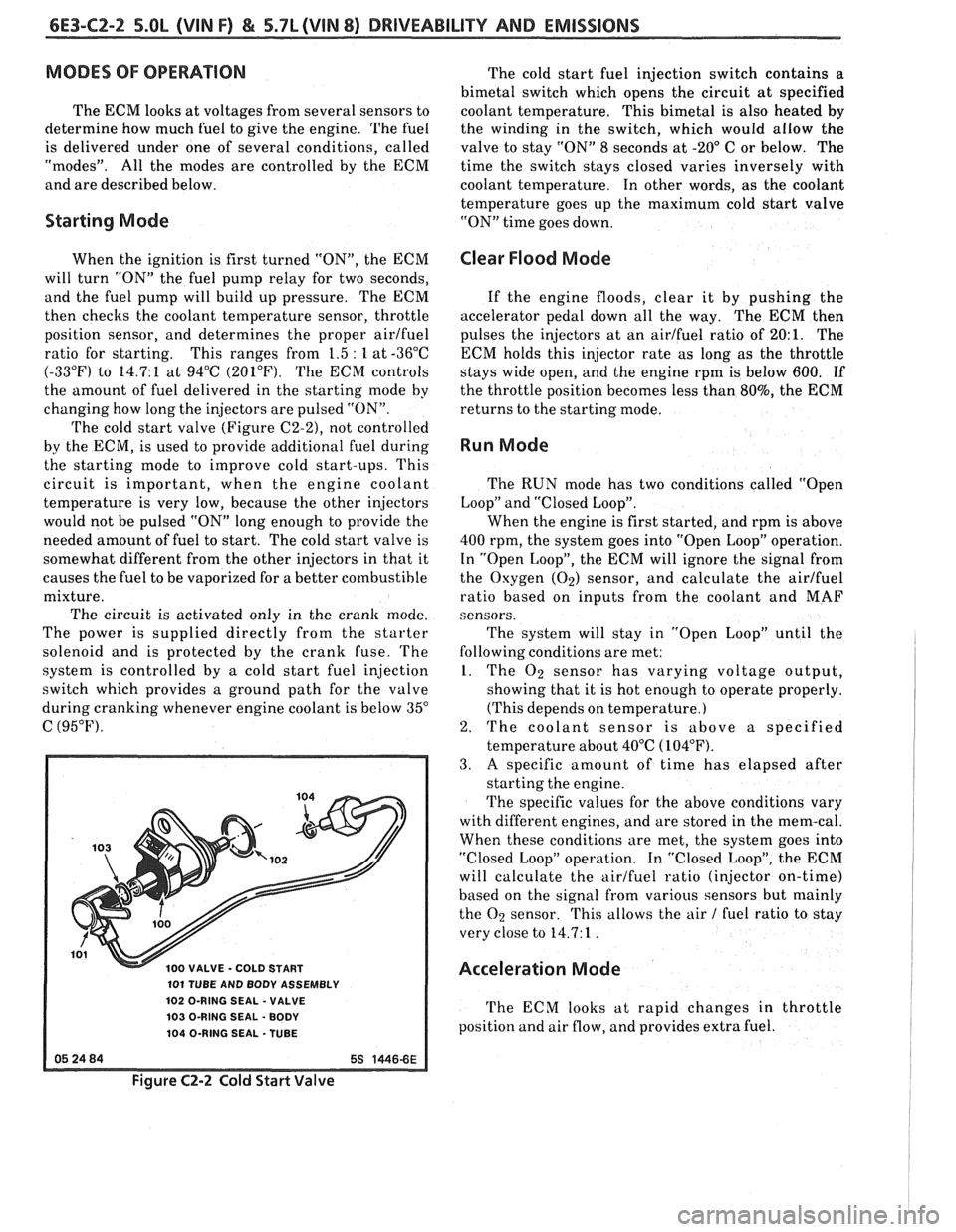
6E3-C2-2 5.OL (VIN F) & 5.7L(VIN 8) DRIVEABILITY AND EMISSIONS
MODES OF OPERATION
The ECM looks at voltages from several sensors to
determine how much fuel to give the engine. The fuel
is delivered under one of several conditions, called
"modes". All the modes are controlled by the ECM
and are described below.
Starting Mode
When the ignition is first turned "ON", the ECM
will turn "ON" the fuel pump relay for two seconds,
and the fuel pump will build up pressure. The ECM
then checks the coolant temperature sensor, throttle
position sensor, and determines the proper airlfuel
ratio for starting. This ranges from 1.5
: 1 at -36°C
(-33°F) to 14.7:l at 94°C (201°F). The ECM controls
the amount of fuel delivered in the starting mode by
changing how long the injectors are pulsed "ON".
The cold start valve
(Figure C2-2), not controlled
by the ECM, is used to provide additional fuel during
the starting mode to improve cold start-ups. This
circuit is important, when the engine coolant
temperature is very low, because the other injectors
would not be pulsed "ON" long enough to provide the
needed amount of fuel to start. The cold start valve is
somewhat different from the other injectors in that it
causes the fuel to be vaporized for a better combustible
mixture.
The circuit is activated only in the crank mode.
The power is supplied directly from the starter
solenoid and is protected by the crank fuse. The
system is controlled by a cold start fuel injection
switch which provides a ground path for the valve
during cranking whenever engine coolant is below
35"
C (95°F).
100 VALVE - COLD START
101 TUBE AND BODY ASSEMBLY
102 O-RING SEAL
- VALVE
103 O-RING SEAL
- BODY
104 O-RING SEAL -TUBE
The cold start fuel injection switch contains a
bimetal switch which opens the circuit at specified
coolant temperature. This bimetal is also heated
by
the winding in the switch, which would allow the
valve to stay "ON" 8 seconds at
-20" C or below. The
time the switch stays closed varies inversely with
coolant temperature. In other words, as the coolant
temperature goes up the maximum cold start valve
"ON" time goes down.
Clear Flood Mode
If the engine floods, clear it by pushing the
accelerator pedal down all the way. The ECM then
pulses the injectors at an airlfuel ratio of
20:l. The
ECM holds this injector rate as long as the throttle
stays wide open, and the engine rpm is below 600.
If
the throttle position becomes less than 80%, the ECM
returns to the starting mode.
Run Mode
The RUN mode has two conditions called "Open
Loop" and "Closed Loop".
When the engine is first started, and rpm is above
400 rpm, the system goes into "Open Loop" operation.
In "Open Loop", the ECM will ignore the signal from
the Oxygen
(Oz) sensor, and calculate the airlfuel
ratio based on inputs from the coolant and MAF
sensors.
The system will stay in
"Open Loop" until the
following conditions are met:
1. The O2 sensor has varying voltage output,
showing that it is hot enough to operate properly.
(This depends on temperature.)
2. The coolant sensor is above a specified
temperature about 40°C
(104°F).
3. A specific amount of time has elapsed after
starting the engine.
The specific values for the above conditions vary
with different engines, and are stored in the mem-cal.
When these conditions are met, the system goes into
"Closed Loop" operation. In "Closed Loop", the ECM
will calculate the airlfuel ratio (injector on-time)
based on the signal from various sensors but
mainly
the O2 sensor. This allows the air 1 fuel ratio to stay
very close to 14.7: 1
.
Acceleration Mode
The ECM looks at rapid changes in throttle
position and air flow, and provides extra fuel.
Figure C2-2 Cold Start Valve
Page 890 of 1825
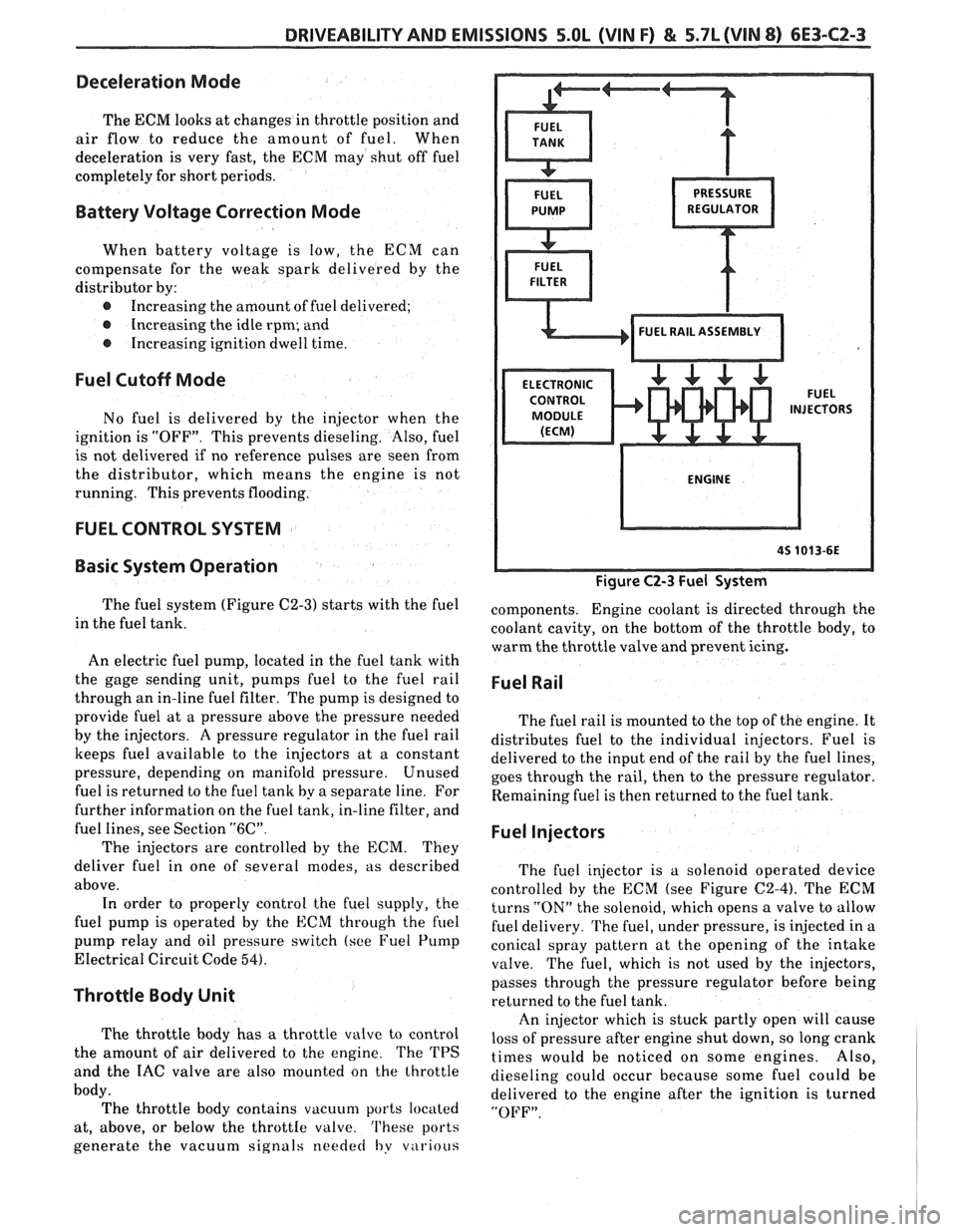
DRIVEABILITY AND EMISSIONS 5.OL (VIN F) & 5.7L (VIN 8) 6E3-CZ-3
Deceleration Mode
The ECM looks at changes in throttle position and
air flow to reduce the amount of fuel. When
deceleration is very fast, the ECM may shut off fuel
completely for short periods.
Battery Voltage Correction Mode
When battery voltage is low, the ECM can
compensate for the weak spark delivered by the
distributor by:
@ Increasing the amount of fuel delivered;
@ Increasing the idle rpm; and
@ Increasing ignition dwell time.
Fuel Cutoff Mode
No fuel is delivered by the injector when the
ignition is "OFF". This prevents dieseling. Also, fuel
is not delivered if no reference pulses are seen from
the distributor, which means the engine is not
running. This prevents flooding.
FUEL CONTROL SYSTEM
Basic System Operation
The fuel system (Figure C2-3) starts with the fuel
in the fuel tank.
An electric fuel pump, located in the fuel tank with
the gage sending unit, pumps
fuel to the fuel rail
through an in-line fuel filter. The pump is designed to
provide fuel at a pressure above the pressure needed
by the injectors. A pressure regulator in the fuel rail
keeps fuel available to the injectors at
a constant
pressure, depending on manifold pressure. Unused
fuel is returned to the fuel tank by a separate line. For
further information on the fuel tank, in-line filter, and
fuel lines, see Section
"6C".
The injectors are controlled by the ECM. They
deliver fuel in one of several modes, as described
above. In order to properly control the fuel supply, the
fuel pump is operated by the
ECM through the fuel
pump relay and oil pressure switch (see Fuel Pump
Electrical Circuit Code
54).
Throttle Body Unit
The throttle body has a throttle valve to control
the amount of air delivered to the engine. The TPS
and the IAC valve are also mounted on the throttle
body. The throttle body contains vacuum ports located
at, above, or below the
throttIe valve. 'I'hese ports
generate the vacuum signals
needed I,y v~irious
Figure C2-3 Fuel System
components. Engine coolant is directed through the
coolant cavity, on the bottom of the throttle body, to
warm the throttle valve and prevent icing.
Fuel Rail
The fuel rail is mounted to the top of the engine. It
distributes fuel to the individual injectors. Fuel is
delivered to the input end of the rail by the fuel lines,
goes through the rail, then to the pressure regulator.
Remaining fuel is then returned to the fuel tank.
Fuel Injectors
The fuel injector is a solenoid operated device
controlled by the ECM (see Figure
C2-4). The ECM
turns
"ON" the solenoid, which opens a valve to allow
fuel delivery.
The fuel, under pressure, is injected in a
conical spray pattern at the opening of the intake
valve. The fuel, which is not used by the injectors,
passes through the pressure regulator before being
returned to the fuel tank.
An injector which is stuck partly open will cause
loss of pressure after engine shut down, so long crank
times would be noticed on some engines. Also,
dieseling could occur because some fuel could be
delivered to the engine after the ignition is turned
"OFF".